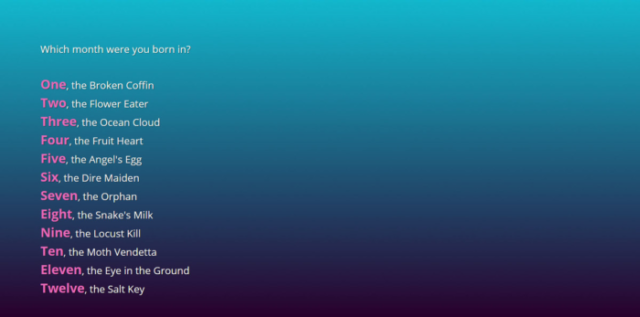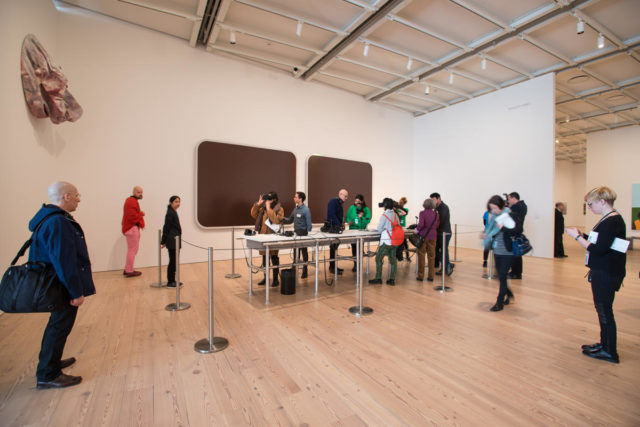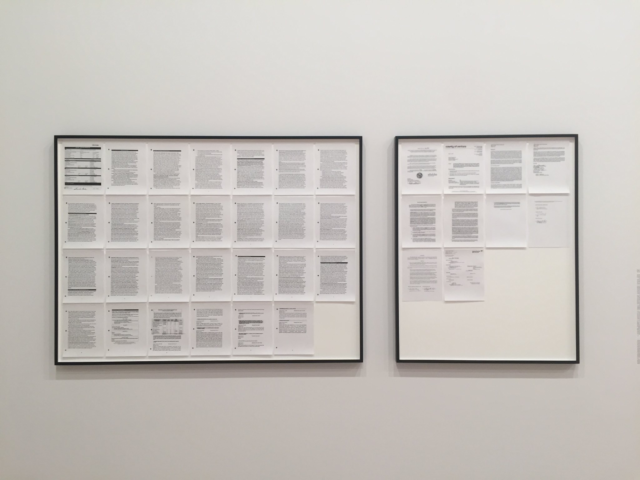The Whitney Biennial is supposed to be a definitive survey of contemporary American Art. Every two years, the curators travel the globe in order to create an exhibition that best depicts the role of art in the world today. As such, its reviews carry more weight than those of individual shows, since they speak beyond the specific works in question, and implicitly and explicitly comment on how art should be. Though any individual critique can be brushed aside as personal taste, studying a broad set allows one to establish patterns among authors and their opinions, and in so doing, discern the assumptions and value criteria that define the always-elusive question of what it means for contemporary art to be good.

With this in mind, I gathered together 32 reviews of the 2017 Whitney Biennial. Though the exhibition has certainly produced much more writing, I narrowed my focus to include only those that attempt to speak in-depth about, and categorize, the show as a whole. This eliminated pieces that primarily show images, writing in the format of a ‘Top __’ list, and articles that focus on only one or two artworks. The problem then, was how to accurately assess the set as a whole. As a quantitative counterpart to close readings of each individual piece, I generated word frequency counts, which help to determine the prominent themes. The more important an artist or idea is considered to be, the more it is mentioned. The frequency counts are calculated by compiling all the text from every article, including image captions, into a plain text file and then running the file through several simple Python commands. These commands, as well as a full list of the reviews studied, can be found in the Data Appendix. Taken as a whole, the reviews present an overwhelmingly positive opinion of the 2017 Whitney Biennial, and center ‘Good Art’ around three major themes: Painting, Politics, and Violence.
Though these certainly entwine, irreparably entangled, it is simplest to parse them out slowly, one at a time, beginning with painting. Mentioned the most of the three, painting’s dominant presence is one of the main narratives of the reviews. Given its prominent place in the ensuing discourse, however, it’s odd that only around 12 of the 63 featured artists are painters. Why then, has such a disproportionate amount of critical attention been devoted to them? There are two main reasons: The first is practical: many reviews were based on the press preview of the biennial, which lasted only a few hours. As Ben Davis remarked, such a short viewing time simply doesn’t allow for fully watching the videos, or engaging some of the more in-depth pieces, like Porpentine Charity Heartscape’s hypertext games. It’s hard to write convincingly about work you’ve never seen, and as a result static mediums are prioritized.

The second reason leads to the next major theme: the political. As many reviews note, this is the first Whitney Biennial since 1997 where the preparations took place during an election year. Accordingly, the rise of U.S. President Donald Trump and his far-right populism looms large. As Chris Sharp notes in Art Agenda, ‘It’s hard to imagine a biennial being under more pressure to signify, to mean, to produce meaning, to attempt to offer some special and tangible insight into our current moment.’ This desire for signification results in a visual favoritism that reduces political action to the representational sphere. Such an emphasis leads to the dominance of figuration, especially in paintings. Henry Taylor and Dana Schutz, for example, are two of the three most mentioned artists, while conceptual artists like Cameron Rowland receive only cursory attention. Despite its sidelining in the reviews, Rowland’s ‘Public Money’ engages the political sphere more directly than any other piece in the exhibition. By having the Whitney purchase a Social Impact Bond—a financial commitment to pay for projects that are seen to have a positive social effect—Rowland creates clear economic and material change.
Through their preference for the optic and distaste for the material, the reviewers imply that the best art can do, is show and reflect, hopefully affecting the viewer and altering their subjectivity. Unfortunately, unlike the contract of a Social Impact Bond, the affective connection between art and subjectivity is not so easily established. As theorists like Susan Sontag (Regarding the Pain of Others) and David Joselit (‘Material Witness: Visual Evidence and the Case of Eric Garner’) have shown, there is rarely a clear, dependable link between visual representation and its effect on the viewer.

The overdependence on representation ultimately results in violence, third theme. For the majority of writers, its depiction in figurative works, no matter how visceral, is justified if it can be understood. As Jennifer Samet makes clear in her Hyperallergic piece, for example, the use of violence is valorized as long as it contributes to ‘a unified, synthetic visual statement.’ This attitude is further revealed in the near universal dislike for Jordan Wolfson’s VR film ‘Real Violence.’ Wolfson is the second most mentioned artist, but all the commentary in the 32 reviews analysed on his work has a negative tone. It is seen as graphic and grotesque, not simply because it is violent, but because it is inexplicably so. No reason is given for the horrific scene that occurs in front of the viewer, and this makes it, for the biennial reviewers, senseless and awful.
The tendencies of the reviewers come even more into focus when ‘Real Violence’ is contrasted with Dana Schutz’s ‘Open Casket.’ The painting depicts the mutilated body of Emmett Till, who was lynched in 1955 after Carolyn Bryant, a white woman, falsely accused him of flirting with her. The work and its inclusion in the biennial has become a source of controversy largely because—as Hannah Black, Aria Dean, and many others have convincingly argued—Schutz, a white woman, co-opted Black pain and suffering, treating it as a raw material for her artistic practice. The discussion around the piece has even expanded beyond the borders of the art world, with Whoopi Goldberg discussing it on the daytime talk show, The View.
While ‘Real Violence’ is loathed, ‘Open Casket’ is adored. Though the work goes beyond the depiction of violence, and indeed embodies it through Schutz’s painterly re-enactment of the lynching of Emmett Till, it is nevertheless seen to be a force for good, because, as curator Mia Locks says, it has “tremendous emotional resonance.” Such a statement seems, at best, incredibly naive. And yet, the characterization of Good Art propagated by the majority of the reviewers necessitates this reading. Its complicity in a history of white supremacy becomes irrelevant, since its visual content is legible. Any ensuing or embodied violence of the work doesn’t matter, since the painting might have use as a message. It is here that the reviewers’ conception of Good Art reaches its breaking point. Violence can never be sublimated into utility.

Instead, as Jean-Luc Nancy writes in The Ground of the Image, “Violence does not participate in any order of reasons, nor any set of forces oriented toward results… Violence does not transform what it assaults; rather, it takes away its form and meaning. It makes it into nothing other than a sign of its own rage, an assaulted or violated thing or being.” By creating a framework in which the best art, like ‘Open Coffin,’ is a figurative painting depicting the violence of today’s politics, the reviews of the Whitney Biennial illustrate the gap between art and the world, a space that requires a reconceptualization of art’s role if it is ever to be bridged.**
The Whitney Biennial 2017 is on at New York’s Whitney Museum, running March 17 to June 11, 2017.













